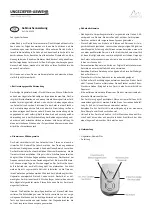
Chapter 31: Load Balancing
STANDARD Revision 1.0
C4® CMTS Release 8.3 User Guide
© 2016 ARRIS Enterprises LLC. All Rights Reserved.
894
Non-bonded DCC Load Balancing means load balancing is done using the Dynamic Channel Change (DCC) directive and can
occur immediately after CM registration time and periodically at the macdomain-check intervals. This applies only to
DOCSIS 1.1 and later non-bonded modems.
Bonded-US-DBC Load Balancing occurs by moving bonded CMs to a different upstream channel-set using the Dynamic
Bonding Change (DBC) directive at the macdomain-check intervals. It applies to D3.0 (US and DS) bonded modems.
Bonded-DS-DBC Load Balancing occurs by moving bonded CMs to a different downstream channel-set using DBC at the
macdomain-check intervals. It applies to D2.0b (downstream only) and D3.0 (US and DS) bonded modems.
Bonded DCC Load Balancing occurs by moving bonded CMs with DCC immediately after CM registration time and
periodically at the macdomain-check intervals. This applies to DOCSIS 2.0b and D3.0 modems. The stipulation is that
bonded modems are DCC’d with init-technique reinit-mac. The primary downstream and upstream channels of a bonded
modem are the primary focus of the move (because the DCC directive only supports one downstream and upstream
destination channel), however, non-primary channels may also change when the downstream and upstream bonding
occurs.
Note: Only the reinit-mac initialization technique is supported for DCC load balancing on bonded CMs. This restriction
does not apply for some cases of the manual move command. See
(page 926) for more
information.
By default, the load balancing group TYPE is set to Static and Non-bonded DCC.
Interactions with Older Cable Modems
Load balancing uses DCC commands to move Cable Modems after they are registered. DOCSIS 1.0 CMs and their
configuration files do not support DCC. These CMs can still be load balanced on upstream channels within a MAC Domain
by static load balancing via an upstream channel override as the CMs first range, prior to their registration. Once a DOCSIS
1.0 CM is registered it remains on its upstream channel until it is reset.
DOCSIS 1.1 and 2.0 CMs with CM software released prior to 2005 are known to have some difficulties with DCC commands.
The following suggestions should maximize the chances for older CMs to successfully move between channels:
If at all possible, upstream channels within a dynamic load balancing group should have identical modulation profiles
and channel width.
If using ATDMA channels, dynamic interleaving should be disabled.
















































